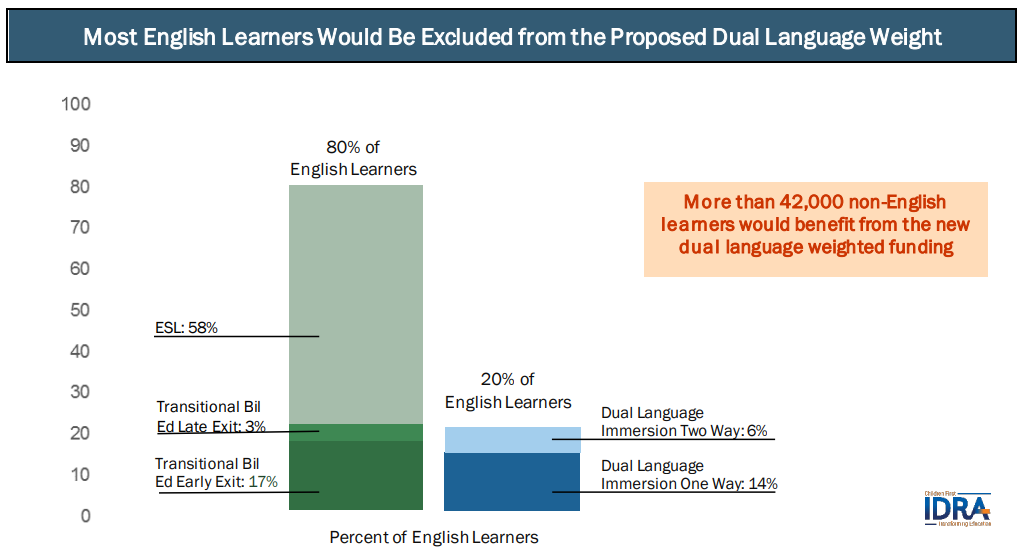• by Morgan Craven, J.D. • IDRA Newsletter • April 2019 •


Programs for English learners also must be compliant with federal law. The Civil Rights Act and the Equal Educational Opportunities Act require that schools develop educational programs that ensure the meaningful and equal participation of English learners. The federally-funded IDRA EAC-South and its predecessors at IDRA have worked with schools to protect the civil rights of English learners.
Types of English Learner Instruction
Bilingual education programs, when implemented correctly, are highly effective methods of instruction and are used primarily in elementary schools, benefitting Texas’ youngest learners. They emphasize the importance of building skills across academic subjects while learning English and drawing on students’ knowledge of their primary language.
Bilingual programs may be designated as either early exit or late exit depending on the amount of time students are kept in the program, which typically ranges from a minimum of two years (early-exit) to six years (late-exit).
Dual language programs are particularly effective bilingual education programs. They focus on developing proficiency in a student’s primary language and in English while achieving grade-level literacy in both languages. Dual language programs can be one-way, in which English learners with the same primary language are in a classroom together, or two-way, in which English learners and non-English learners are in a classroom together.
Insufficient and Outdated Funding
English learners in Texas make up about one-fifth of the public school population, or 1 million students. Most are in elementary schools. Support for English learners is especially critical during the time of early education and pre-K, when students are developing the most basic skills needed for academic and social success. These students are an asset to their communities and to Texas. Funding their education, starting early, should be seen as an investment in the future of the state.
In the mid-1970s, IDRA led a research effort to examine the funding levels needed for effective implementation of bilingual education, finding that most programs suffered from significantly inadequate funding.
Over four decades later, English learners still receive far less than their fair share of funding in Texas. State law assigns a percentage (or weight) that schools receive per English learner student to pay for such costs as assessment, curriculum and bilingual materials, and teachers trained in English learner instruction.
Currently, the weight for English learners in Texas is 0.1, so schools receive 10% more funding than for the average student. The 0.1 weight was set in 1984 by the Texas Legislature, which did so in an arbitrary manner. At the time, the recommendation from researchers, including at IDRA, was that English learners receive 40% more funding than the average learner, or a weight of 0.4. That recommendation was ignored, and the original low funding weight has not been increased since then.
Limited Proposals Being Debated
In the current Texas legislative session, the major school finance proposals would increase funding to serve some English learners. Those proposals seek to incentivize the implementation of dual language programs. They maintain the same low 0.1 weight for most English learners but create an additional new 0.05 weight for English learners enrolled in dual language programs.
House Bill 3 also creates a 0.05 weight for non-English learners (students whose primary language is English) who are in two-way dual language programs. The proposals also include an additional weight for English learners in kindergarten through third grade – money that, under both plans (SB4 and HB3, can be used to fund a district’s pre-K program.
Funding dual language programs is important. These programs are highly effective and help students to develop bilingualism, biliteracy, and, in two-way programs, an appreciation of a culture that may not be their own.
But, we cannot ignore the fact that most English learners will not benefit from this proposed change. IDRA’s analysis of data obtained from the Texas Education Agency shows that 80% of English learners in the state are not in the dual language programs that would receive funding under the proposed changes to the law. That means that 80% of English learners in the state –roughly 800,000 students – would be left with the same insufficient funding weight that has been in place since 1984. That includes students in ESL programs but also a significant number of young students in other types of bilingual education programs. Even if the 0.05 added weight reached all English learners, the state would still be grossly underfunding their education.


In Texas, 414,110 kindergarten through third grade students were identified as English learners in 2017-18. While the additional funding for English learners in kindergarten through third grade is a step in the right direction, the House and Senate measures (as of the time of writing) allow districts to use the funds for prekindergarten programs for educating both English learners and non-English learners. Funding prekindergarten is critical, but the fact remains that many English learner students in bilingual education programs in early grades will not benefit from the targeted and specific increase in funding in the bills. Texas is still leaving many students behind.
In order to support English learners in Texas and ensure they have meaningful and equal access to educational opportunities from early education on, we must invest in them. Funding matters, and how and where dollars are spent speaks volumes about how we view the potential of students.
Morgan Craven, J.D., is the IDRA National Director of Policy. Comments and questions may be directed to her via email at morgan.craven@idra.org.
[©2019, IDRA. This article originally appeared in the April 2019 IDRA Newsletter by the Intercultural Development Research Association. Permission to reproduce this article is granted provided the article is reprinted in its entirety and proper credit is given to IDRA and the author.]


